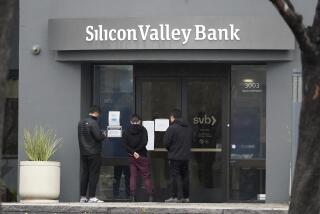Analysts Hail Firm’s Policies, Knowledge of Field : Downey S&L; a Natural to Run Butterfield
- Share via
When Downey Savings & Loan was tapped by the Federal Home Loan Bank Board last week to take charge of insolvent Butterfield Savings & Loan Assn., industry observers may have been surprised by the speed of the government’s move, but not its choice.
The 28-year-old, Costa Mesa-based Downey has impressed not only government regulators, but industry analysts and stockholders alike with its consistent profits, stability and conservative management.
In the fast-paced world of deregulation where financial institutions have faltered or in Butterfield’s case have failed with risky restaurant and real estate ventures, Downey has flourished on a more cautious investment course, resisting many of the temptations of California’s liberal banking laws.
“They just stick to what they know,” said Allan Bortel, a savings and loan analyst with Shearson Lehman Bros. in San Francisco. “They know real estate better than most any S&L;, so they are very appropriate people to be running Butterfield.”
Primary Function
The primary function of an S&L; is to loan money for mortgages and construction, be it of private homes, residential or commercial projects. Downey, it seems, has done well on all fronts, in part because of the expertise of its top two executives.
As Downey’s co-founder Gerald McQuarrie tells it, he was in the mortgage banking business in the 1950s when he met Maurice McAlister, a builder.
“We were talking one day and decided we didn’t like how they were running the S&Ls; at that time . . . we didn’t like their attitude of taking three months to get a commitment through,” McQuarrie, 64, recalled. “A builder wants to start pounding nails. We said if we had our own S&L; . . . we would give them quick service.” Moreover, McQuarrie said, “We knew costs, so we would be very accurate on making loans.”
McQuarrie and McAlister’s relationship officially began Oct. 16, 1957, in a 30-by-70 foot office that was to become the first of more than 40 Downey branches to come. With the two men sharing teller, bookkeeping and loan application duties, McAlister and McQuarrie were able to keep costs down and monitor everything themselves. “You may not believe this,” McQuarrie said chuckling at the thought, “on Sunday we went in and swept the place out.” The first day they had taken in $300,000 and by the end of the year, McQuarrie said, Downey had posted “an unheard of” $16,000 profit.
Over the next 28 years, McAlister and McQuarrie built a company, which today boasts $2.3 billion in assets, record earnings in the second quarter of this year and stock that has more than doubled in value since the company went public in 1971. In addition, the savings and loan is one of the largest shopping center developers in the West.
One analyst referred to the self-described home-grown bankers who take turns driving each other to work each day, as “good old boys” whose simple style and easy-going manner is deceiving.
“They know the right people, they keep their shop clean, and know all the correct rules and regulations of the industry,” the analyst said. “But behind that plain folks facade, they are extremely shrewd.”
Respected by Regulators
Not least among Downey’s good fortunes is that they have apparently gained the respect of the government regulators.
Asked whether Downey would reap any benefits for itself by pitching in to help out government regulators with Butterfield for the next three months, McQuarrie said “When the industry benefits, we benefit. This is a better way than just throwing everything down the tube.”
“Downey has a good image with its depositors,” Bortel added. “Maybe the thinking is that that will give Butterfield depositors more confidence.” As for why one S&L; succeeds under deregulation where another one fails seems to be a question of approach.
“We kept with the traditional, conservative ways of doing business,” McQuarrie said. Referring to Butterfield’s controversial practices of using depositors’ money to buy Love’s Barbecue and Wendy’s hamburger outlets, as well as a nationwide telephone campaign to sign up $100,000-plus depositors, he added, “They jumped pretty fast.”
More to Read
Inside the business of entertainment
The Wide Shot brings you news, analysis and insights on everything from streaming wars to production — and what it all means for the future.
You may occasionally receive promotional content from the Los Angeles Times.










